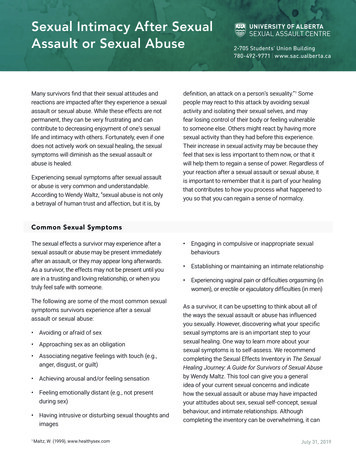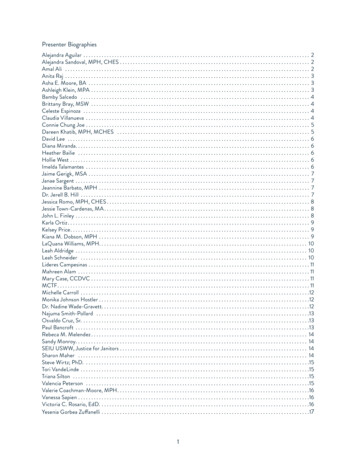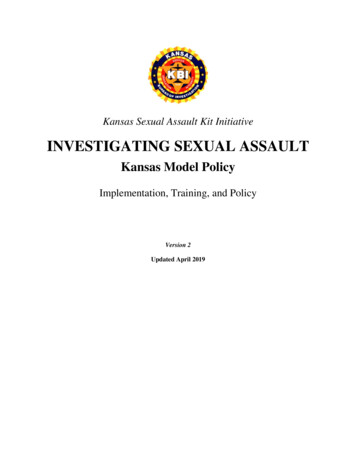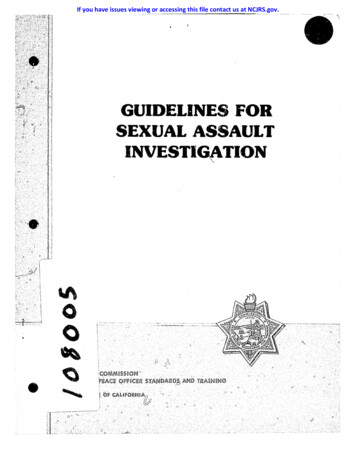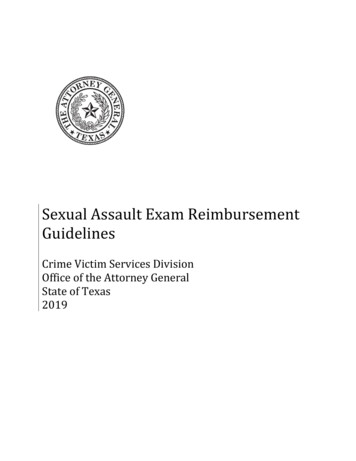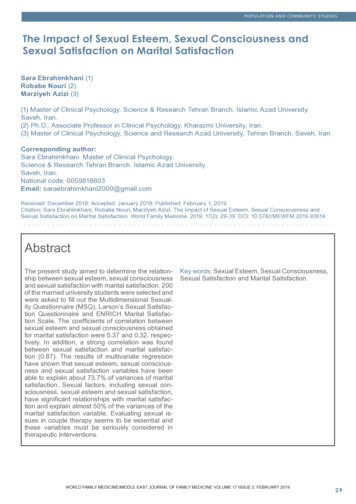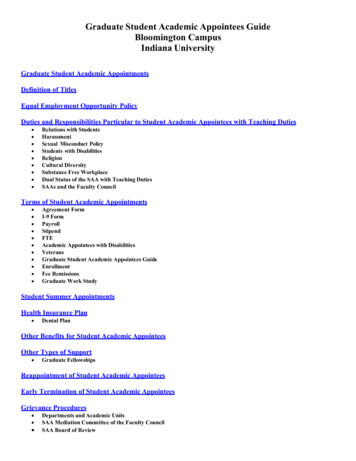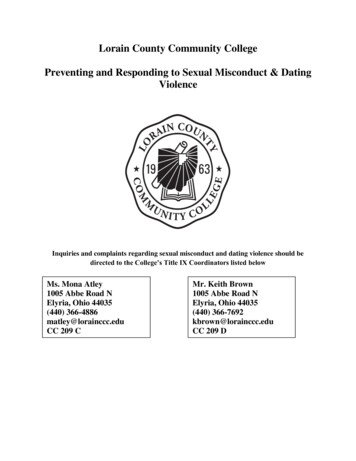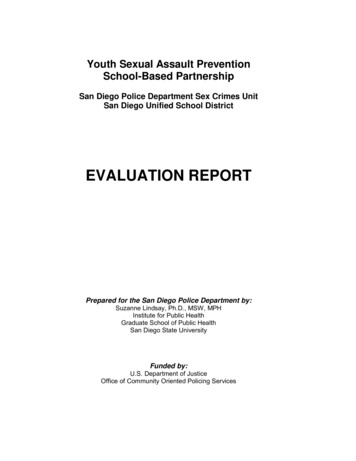
Transcription
Youth Sexual Assault PreventionSchool-Based PartnershipSan Diego Police Department Sex Crimes UnitSan Diego Unified School DistrictEVALUATION REPORTPrepared for the San Diego Police Department by:Suzanne Lindsay, Ph.D., MSW, MPHInstitute for Public HealthGraduate School of Public HealthSan Diego State UniversityFunded by:U.S. Department of JusticeOffice of Community Oriented Policing Services
For More InformationFor more information about:1.The Sexual Assault Curriculum Developed by this projectTo obtain copes of the curriculum materials please contact:San Diego Police DepartmentSex Crimes Unit1401 BroadwaySan Diego, California 92101-5729(619) 531-2210Curriculum materials can also be downloaded from the Sexual Assault Trainingand Investigations website at: http://www.mysati.com (click on resources).2.Working with Local School Districts:Marge Kleinsmith-HildebrandResource Teacher, Student Support ServicesWiggin Center4350 Mt. Everest BlvdSan Diego, California, 92117mkleinsm@mail.sandi.net3.The evaluation of this project or other criminal justice interventions:Suzanne Lindsay, Ph.D., MSW, MPHGraduate School of Public HealthSan Diego State University6505 Alvarado Road, #116San Diego, California 92120(619) 594-8945slindsay@mail.sdsu.edu2
Table of ContentsChapterPageExecutive Summary4Chapter 1:Student Survey Results13Chapter 2:Parent Survey Results22Chapter 3:Teacher Survey Results28Chapter 4:Law Enforcement Survey Results37Chapter 5:Victim Advocate Survey Results53Chapter 6:Medical/Forensic Examiner Survey Results61Chapter 7:Comparison of Stakeholder Groups68Chapter 8:Focus Groups803
Youth Sexual Assault Prevention School-Based PartnershipEvaluation ReportExecutive SummaryThe Youth Sexual Assault Prevention School-Based Partnership was a collaborativeeffort between the San Diego Police Department (SDPD) Sex Crimes Unit and the San DiegoUnified School District. The purpose of the project was to develop, pilot test, and implement asexual assault curriculum to be used with high school and middle school students. TheInstitute for Public Health at San Diego State University provided analysis and evaluationservices to this project through a sub-contract. Results of the analysis are described using theScanning, Analysis, Response and Assessment (SARA) model.ScanningAlthough the SDPD had been actively involved in Problem-Oriented Policing since1988, in the early 1990s few investigative units had examined ways to practice problem solvingor contribute to prevention efforts. In 1993, the SDPD Sex Crimes Unit began to applytraditional crime analysis techniques to the sex crimes reported to the unit. The Unit‘s goalwas to learn as much as possible about the victims, offenders, and the environment of theassault. The analysis included the relationship between the victim and suspect, the age of thevictim and suspect, their sexes, ethnicity, the type of assault (crime code classification), thegeographical and physical location of the assault, the time of day, day of the week, and otherfactors such as whether a weapon or drugs and alcohol were involved. Data was analyzed forthe entire preceding year (1992).It was found that non-stranger sexual assaults accounted for 69% of the 788 sexualassaults reported to the SDPD in 1993. Upon further examination, it became apparent that thevictim had the ability to make decisions prior to the assault that could have greatly reduced herrisk of being sexually assaulted. Adolescents are particularly vulnerable to the crime of nonstranger sexual assault. Adolescent behavior and attitudes that encourage risk taking and theexploration of relationships with the opposite sex can also provide opportunities for predatorysexual encounters in an environment where the adolescent may not be aware of or understandthe clues that indicate that he or she is in danger.Most police officers understand that terrible things happen, and often there is nothinganyone can do to stop such tragedies as traffic accidents and random acts of violence.However, in the majority of the non-stranger sexual assault cases analyzed, it was clear thatthe victim had many opportunities to recognize factors that increased her risk of sexual assault.The problem was that she didn‘t understand her risk. Community prevention messages aboutsexual assault did not contain information that would have helped the victim to recognize andreduce her risk of non-stranger assault because of the continued focus on stranger danger.Unfortunately, it is more comfortable for people to think that a woman or child is most at riskamongst strangers than the people they love and believe they can trust. By continuing to denythe truth, and focusing their prevention efforts on only stranger assault, the SDPD Sex CrimesUnit felt that law enforcement was also not adequately addressing the problem.4
The SDPD Speaker’s Bureau: The Challenging Road to ImplementationIn 1993, a 40-hour Speaker‘s Bureau Academy was held to train volunteers to deliver anew sexual assault educational presentation developed by the San Diego Police Departmentwith a focus on non-stranger sexual assault. The Speaker‘s Bureau includes a diverse groupof speakers, both male and female, from several different ethnic backgrounds, ranging in agefrom 25-65 years. The intended audience for this presentation was any community agency, orgroup with an interest in the topic including students of high school and middle school age.In 1995, after several meetings and modifications to the original Speaker‘s Bureaupresentation, a 50-minute curriculum was accepted by the San Diego Unified School District forhigh school students. The presentations have been very well received. As of June 2000, theSDPD has provided a total of 542 presentations to members of the community, the majority tohigh school and college age students. This represents more than 16,000 individuals who havereceived this vital information.The SDPD analysis clearly indicated that 75% of the sexual assault victims whoreported to the SDPD were between 14 and 25 years of age. Thus, it was our desire to expandon the 50-minute high school presentation and to create a comprehensive sexual assaultcurriculum that had material appropriate for both high school and middle school students.The U.S. Department of Justice, Office of Community Oriented Policing Services fundedthe Youth Sexual Assault Prevention School-Based Partnership, thus providing us with theopportunity to develop, pilot test, and evaluate this comprehensive curriculum.AnalysisStakeholder Surveys and Focus GroupsOne of the first priorities in the development of the sexual assault curriculum foradolescents was to obtain input from key stakeholder groups as to the appropriate content andmethod of this instruction. The project identified six stakeholder groups whose input wassolicited: 1) students, 2) parents, 3) teachers, 4) law enforcement personnel, 5)medical/forensic examiners, and 6) sexual assault victim advocates. Anonymous surveys weredeveloped and administered by the project using convenience sampling techniques for eachstakeholder group. The responses to these surveys were used for the specific purpose ofcollecting information for the development of curriculum materials and are not intended to berepresentative of a general population of the identified stakeholder groups. Chapters 1-6 of thisreport describe in detail the results of those surveys. Chapter 7 provides a comparison of theresponses of different stakeholder groups to the surveys.In addition, four different types of stakeholder groups participated in five focus groups tofurther enhance our understanding of how this curriculum should be developed. The focusgroup participants included: 1) two focus groups of students, 2) one focus group of victimadvocates, 3) one focus group of law enforcement personnel, and 4) one focus groups ofSDPD Sex Crimes Speaker‘s Bureau instructors. Chapter 8 of this report contains the findingsof the focus groups. The SDSU Institute for Public Health provided the analysis of survey andfocus groups results.5
Major findings from this analysis include:1.2.Level of knowledge about sexual assault reported to law enforcement Overall, only 36% of stakeholders respondents surveyed knew that 75% or moreof sexual assaults reported to law enforcement involved non-strangers.Students were the least likely to know this (19%), while victim advocates werethe most likely to know it (66%). Most survey respondents indicated that they believed the most common locationfor adolescent sexual assault to occur was in the victim‘s home. In reality, mostadolescent assaults occur in the suspect’s home or at a party or gathering. Survey respondents correctly identified the evening hours as the most likely timeof adolescent sexual assault. Parents and teachers also correctly recognizedthe after-school hours as a time of high-risk. All stakeholder groups understood that drugs and alcohol are frequently involvedin adolescent sexual assault. Overall, 44% of adult survey respondents indicated that they felt adolescentsexual assault victims were less likely to be believed than adult victims. 78% of students, 97% of victim advocates, 80% of law enforcement personnel,81% of parents, 90% of teachers, and 100% of medical/forensic examinerssurveyed indicated that it would be —helpful“ or —very helpful“ for them to learnmore about sexual assault.The Development of a Sexual Assault Curriculum for Adolescents 100% of victim advocates, 99% of parents, 97% of teachers, 94% of lawenforcement personnel, and 100% of medical/forensic examiners responded that itwould be —helpful“ or —very helpful“ for adolescents to learn more about sexualassault. 93% of victim advocates, 80% of law enforcement personnel, 78%of parents, 85% of teachers, and 88% of medical/forensic examiners indicatedthat a sexual assault curriculum should be taught in school. 62% of adult survey respondents indicated that content related toadolescent sexual assault should begin in the schools in grades 7/8 or earlier. Adult respondents indicated that this curriculum could be taught bya variety of professionals including classroom teachers, life skills teachers,counselors, law enforcement personnel, and guest speakers from advocacyorganizations. Interestingly, students had a strong interest in learning thismaterial from victims and perpetrators. All stakeholder groups valued different formats of instruction6
including group discussion (61%), guest speakers (59%), movies/videos (54%),and lectures (31%). Students were most interested in guest speakers andmovies/videos.3.The Content of an Adolescent Sexual Assault CurriculumStakeholder groups identified 48 different content areas that could be included in asexual assault curriculum for adolescents. These are listed in Chapter 8 of this report. Thetop 11 choices in order of frequency include: Definitions of rape and sexual assault—No means no“Laws and punishment related to sexual assaultMost assaults are perpetrated by non-strangersWhat to do to report the crimeWho is at risk for sexual assault and why?Alcohol/drugs and sexual assaultSelf-respect/trust your instinctsHow to protect yourself from sexual assaultHow rape victims are supported by the communityThe risk of sexually transmitted diseasesResponseIn response to the extensive input from stakeholder groups, the Youth Sexual AssaultPrevention School-Based Partnership developed a comprehensive multi-faceted adolescentsexual assault curriculum. The curriculum contains a number of components that can be usedwith adolescents of different age groups, and in different environments. Some componentswere developed specifically for this project. In addition, other existing resources were alsoevaluated by the team and included as excellent educational material. Educators can selectfrom an array of material and activities designed to enhance adolescent knowledge in the topicarea and encourage role-playing to improve communication in potentially dangerous or riskysituations.To obtain copies of the curriculum materials please contact the San Diego PoliceDepartment Sex Crimes Unit, 1401 Broadway, San Diego, California 92101-5729 or (619) 5312210. Curriculum materials can also be downloaded from the Sexual Assault Training andInvestigations website at: http://www.mysati.com. Click on resources.Components of the developed curriculum include: A curriculum binder that contains the following:oBackground information for teachers containing information about U.S.government sexual assault crime statistics, legal definitions of sexual assault,research related to the effects of sexual assault, and instructional considerationsfor teaching this content.oTwo chapters with material developmentally appropriate for grades 10-12including: What is sexual assault? Sexual assault risk reduction7
Setting sexual limitsoTwo chapters with material developmentally appropriate for grades 9-12including: Decision Making Assert Yourself!oTwo chapters with material developmentally appropriate for grades 6-9including: Who would you ask? Who would you tell? Green light, yellow light, red lightThe chapters in the curriculum binder can be used as stand-alone modules or incoordination with one another. The chapters contain educational messages,transparencies, teaching steps, teacher tips, examples of case scenarios, risk reductiontips, student worksheets, and suggestions for activities such as brainstorming, classdiscussions, continuums, small group discussions, dyads, role plays, and teacherlectures. The curriculum binder was designed so that educators could create a custompresentation for any high school or middle school class with materials especiallyselected by the instructor to match the needs and developmental age of his or herclassroom. A Power Point slide show for use with a high school student audience. This showincludes statistics about adolescent sexual assaults reported to the San Diego PoliceDepartment and includes case scenarios specifically designed for high school students. A Power Point slide show for use with a middle school student audience. This showemphasizes the development of healthy relationships, appropriate boundaries, andrecognizing how to trust your instincts. Information about child abuse and sexualharassment for 6th and 9th graders included. A Power Point slide show focusing specifically on the California sexual assault lawsmost commonly applied to high school students, ways to reduce the risk of sexualassault, what both men and women need to know about sexual assault, and what to doif you become a victim. A number of brief Public Service Announcements (PSA) that describe adolescentsexual assault and the community response. The PSA‘s emphasize that non-strangersexual assault and stranger sexual assault are both criminal behavior, they provideinformation about resources available to victims of sexual assault, and they encourageadolescent girls to watch out for each other in party situations or at gatherings. Informational brochures designed for students with relevant sexual assault material.o 50 things everyone should know about date and acquaintance rapeo Alcohol, drugs, and date rapeo A brochure originally designed for college age students is undergoingmodifications for use with a high school audience including lists of localcommunity resources. A student bookmark describing five ways to reduce your risk of sexual assault.o Strength in numbers: Use the —buddy“ system or go on group dateso Remember, alcohol can distort your judgment.8
ooo No substance abuse!Know your limits. It‘s never too late to say no.Say what you expect from your date. Be up front.An informational brochure designed for parents (The Parent Tip Brochure) describingthe facts about adolescent sexual assault, the laws related to sexual assault, how tohelp your teen be safe, and what to do if a sexual assault occurs. A list of localresources with telephone numbers is provided on the back of the brochure.AssessmentMultiple approaches were used to assess the success of the development of the YouthSexual Assault Prevention School Based Partnership curriculum.1.Is the content correct as suggested by the stakeholder groups?The input of key stakeholder groups was reviewed for their suggestions for curriculumcontent. Stakeholder groups identified 48 possible content areas that could be included in anadolescent sexual assault curriculum (See Chapter 8 for this comprehensive list). Forevaluation purposes, the developed curriculum content was compared to the contentrecommended by the stakeholder groups. Ninety-four percent (94%) of the suggested contentareas were successfully incorporated into one or more areas of the curriculum or other supportmaterial. The three suggested areas that are not in the current version of the curriculuminclude: 1) education about male victims and the risk of male victimization, 2) how males canbecome involved in educational efforts to prevent sexual assault, and 3) the general subject ofincest. These three content areas of interest to stakeholders have been communicated tothose responsible for the development of the curriculum.2.Middle School Pilot TestThe newly developed Middle School curriculum with a Power Point slide show was pilottested with a class of middle school students with great success. The content seemedappropriate, there were no unanticipated negative consequences, and it was generally felt byboth the instructors and the students that it was an important educational experience. Writtenevaluations were very positive.3.Pamphlets, Brochures, and BookmarksStudent and adult stakeholder focus groups were used to help evaluate the developedand selected pamphlets and brochures to ensure that the content was age anddevelopmentally appropriate, and of interest to the intended audience.The law enforcement and SDPD Speaker‘s Bureau focus groups were asked to comment onthe high school brochure and the parent tip brochure. They were asked to assess specificelements of the brochure on a scale of 1-5, with 1 being poor and 5 being excellent. Theresults show favorable responses by both groups with the Speaker‘s Bureau instructors morefavorable to both brochures.9
Table 1. Focus Group Assessment of the High School BrochureSpeaker’s BureauBrochure CharacteristicLaw EnforcementMean scoreMean score(n 6)(n s3.74.5Font4.04.3Overall3.94.3Table 2. Focus Group Assessment of the Parent Tip BrochureSpeaker’s BureauBrochure CharacteristicLaw EnforcementMean scoreMean score(n 6)(n 14)Size4.24.7Cover3.94.2How to help your teen besafe messages4.34.7What to do if a sexualassault occurs messages4.44.7Sexual assault laws4.44.5Resource list4.44.8Overall4.34.6Students were asked to assess three items during their focus groups: 1) the pamphletentitled “Alcohol, Drugs, and Date Rape,“ 2) the pamphlet entitled —50 Things Everyone shouldknow about Date and Acquaintance Rape,“ and 3) the sexual assault informational bookmark—Anyplace, Anytime, Anyone.“ In general, the students liked the pamphlets more than thebookmark. There were comments that the bookmark was not colorful enough, and that the textwas too cluttered on the bookmark. Students indicated that they probably would not pick upthese items in general, but they thought that they should be available in such spots as thestudent counseling office, health office, etc.Table 3. Student Assessment of Two PamphletsBrochureAlcohol, Drugs, and DateCharacteristicRape(n rall4.550 Things EveryoneShould Know(n 35)4.24.34.34.54.24.510
Table 4. Student Assessment of the Informational BookmarkBrochureCharacteristic35 Student respondentsSize3.25 ways to reduceyour risk message3.8What men andwomen need to know3.9messageOverall3.74.Public Service Announcements (PSAs)Three public service announcements were shown to student focus groups to assess theirresponse. The following are comments received directly from students. 5.Don‘t use statistics in public service announcements too boring.Don‘t use guilt. A young girl worrying about whether or not she appropriately watchedout for her friend did not make a good impression on the students.One of the PSAs involved a girl‘s soccer team and messages to use the —buddysystem.“ Those interested in soccer found it interesting and engaging because theyrecognized famous individuals in the PSA. Those who had no interest in soccer orsports in general did not find it engaging, and did not hear the message.The students were most impressed by the PSA with the message —rape is rape.“ ThisPSA showed case scenarios of stranger assault and non-stranger assault making theargument that it is the same crime. The PSA involved a lot of action and music thatappealed to students. They appeared to easily hear and understand the message.Examination of Police ReportsFinally, the last method used to evaluate the effectiveness of the educational effortswas to examine the annual number of reports of adolescent sexual assault to law enforcement.The San Diego Association of Governments (SANDAG) collects information about juvenilevictims of violent crime for monitoring and evaluation purposes.Many factors can influence the reporting of adolescent sexual assaults to lawenforcement. For this reason, the examination of trends in reporting cannot prove that aparticular intervention —caused“ the trend. Trend findings are just the first step that wouldencourage a more rigorous evaluation design. But they are a necessary first step, and shouldbe followed up to confirm whether a trend actually represents an intervention effect whenmeasured with a more controlled design.As expected, when the San Diego Police Department first initiated the Speaker‘sBureau presentations to high school age students in 1995, the reporting of this crime actuallyincreased among adolescents attending the San Diego Unified School District. This increase inreporting was expected as more students were educated about the nature of this crime andhow to respond to it (reporting bias). Since 1995, the Speaker‘s Bureau has providedapproximately 500 presentations to high school students, always refining the content ofpresentations with updated crime data and the latest information about current laws. Thedevelopment of the comprehensive sexual assault curriculum funded by the Office of11
Community Oriented Policing Services has provided the ability to continue to augment thematerials and efforts of the Speaker‘s Bureau since the year 2000.Table 5 describes the number of adolescent rapes reported and documented in SanDiego by SANDAG in calendar years 2000 and 2001, and the percent change between the twocalendar years (rape is a sub-category of all types of sexual assault as defined in the federalUniform Crime Report - UCR). The table is organized by the time of day of the assault. Fromthe table, it appears that there is now an encouraging downward trend in the reporting of thiscrime among adolescents in San Diego, particularly in the daytime and after school hours. Inaddition, in calendar year 2000 there was also a similar downward trend in the reporting of thecrime of unlawful sexual intercourse with a minor (statutory rape). Interestingly, there was nosimilar downward trend in San Diego in the reporting of sexual crimes against adult women,suggesting that there is some factor influencing the adolescent population not present foradults. Further studies would be helpful to determine with more certainty whether or not theeducational efforts pursued through this project had a significant influence on this finding.Table 5. A Comparison of Adolescent Reports of Rape in San Diego: 2000 – 2001Time PeriodNumberNumber%Change20002001Daytime Hours0830 -13291915-21%After School Hours1330 - 21594835-27%Curfew Hours2200 - 082940438%All hours10793-13%12
Chapter 1Student Survey ResultsStudent DemographicsThe student survey was distributed to students attending a San Diego PoliceDepartment (SDPD) Speaker‘s Bureau presentation sponsored by the San Diego UnifiedSchool District. Eight different classes at seven schools (five high schools and two middleschools) were surveyed. Convenience sampling was used. The student responses to thesesurveys were used for the specific purpose of collecting information for the development ofcurriculum materials and are not intended to be representative of a general population ofstudents. The survey questions asked respondents to describe their knowledge of adolescentsexual assault, whether or not they would like to learn more information in this topic area, andhow this information might best be taught. No questions about behavior, attitudes, or beliefswere included in the survey. Completion of the survey was entirely voluntary and anonymous.School district personnel decided which classes would be surveyed based on convenience andease of scheduling. No formal sampling strategies were used, but an attempt was made toinclude students ages 14-18 years, to survey both male and female students, and to surveyschools in different geographic areas of the city. A total of 388 completed student surveysanalyzed for this project.Fifty-six percent (56%) of the student respondents were female, 43% male, and 1% (2students) unknown. In general, the ratio of male to female respondents in each class settingwas nearly equal in six of the eight classes surveyed. Two high school classes were femaleonly. Twenty-four percent (91) of the students surveyed were under 14 years of age, 53%(207) were 14-15 years, 17% (66) were 16-17 years; and 5% (21) were 18 years or older.Figure 1 graphically displays the number of student respondents by age and gender.Ten percent of the students were in the 7th grade, 29% in the 8th grade, 27% in the 9thgrade, 16% in the 10th grade, 10% in the 11th grade, and 7% were in the 12th grade. Table 1.1displays the number of students surveyed by school type, age, and gender.Student Age and GenderNumber of StudentsFigure 1:14012010080604020011690Male424922 14Female4414-1516-1712918 Age in Years13
Table 1.1.SchoolABCDEFGHGrade in School by GenderSchoolGrade in SchoolGenderththType89th 10th 11th7MiddleM23 25F17 4 102613827Gender 101313244925GrandTotal382**Missing data, 6 respondentsPrevious Education or Communication about Sexual AssaultStudents were asked if they had ever previously received education about sexualassault or rape. Sixty percent (60%) of the students reported they had, in fact, received thistype of education. The sources of this education were quite varied including: School:89% Parents/home:15% TV/advertising:8% Books/magazines/computers:2% Other4%(including Planned Parenthood, church, youth group, peer counseling, work,police academy, and after school programs).Students were also asked if they had ever spoken with others about sexual assault.Overall, 63% indicated that they had spoken with others about this topic including talking with: Friends/peers74% Parents52% Teachers24% Relatives15% Doctors6% Others9%(including church members, co-workers, police/firemen, counselors, schooladministrators, psychologist/psychiatrist, and martial arts instructor).14
Knowledge of Sexual AssaultRelationship, location, drugs and alcoholStudents were asked a number of questions to determine their understanding of thecharacteristics of adolescent sexual assault reported to the San Diego Police Department(SDPD). The SDPD Sex Crimes Unit collects and maintains statistics on all sexual assaultsreported to law enforcement including a comprehensive description of the context andcharacter of the assault (i.e. age of the victim and suspect, relationship between victim andsuspect, location of assault, etc.). It is known that approximately 75% of adolescent sexualassaults reported to the SDPD involve non-strangers (acquaintances). It is also known that themajority of adolescents (56%) report being assaulted in the suspect‘s home (30%) or anotherindoor location such as a party or gathering (26%), and that drugs and alcohol are ofteninvolved in these acquaintance assaults (31-51% of cases). Survey questions were asked toassess whether or not students had an understanding of these facts. Table 1.2 shows thatonly 19% of student respondents understood that 75% or more of reported adolescent sexualassaults involve acquaintances. Students appear to recognize the potential danger of a partyor gathering (65% indicated that this was the most likely location for an adolescent sexualassault to occur), but seem relatively unaware of the risk of assault in a suspect‘s home, acrime that involves a significant betrayal of trust. The students clearly seemed to understandthat drugs and alcohol contribute to the risk of adolescent sexual assault. 81% responded thatdrugs and alcohol were often or almost always involved in adolescent sexual assault. This mayactually over-represent the influence of these substances on this crime.Table 1.2.Student Knowledge of Situational Characteristics of Adolescent SexualAssaultRespondentSurvey QuestionResponse ChoicesNumberPercentRelationship6517%Percent of suspects Less than 25%who are25-50%13334%acquaintances (i.e.51-75%11229%two people whoGreater than 75%7419%know each other)?No response41%Total388100%LocationVictim‘s home4211%Most likely locationfor adolescentParty or gathering25165%sexual assault?Suspect‘s home267%Outdoors4211%Combination of215%aboveNo response61%Total388100%15
Table 1.2. (continued)Response ChoicesDrugs/AlcoholHow often are drugs Neverand alcohol involved Sometimes but notin sexual assault?oftenOftenAlmost alwaysNo %1%100%No statistically significant differences were found either by gender or age in thestudents‘ est
4350 Mt. Everest Blvd San Diego, California, 92117 mkleinsm@mail.sandi.net 3. The evaluation of this project or other criminal justice interventions: Suzanne Lindsay, Ph.D., MSW, MPH Graduate School of Public Health San Diego State University 6505 Alvarado Road, #116 San Diego, California 92120 (619) 594-8945 slindsay@mail.sdsu.edu 2
